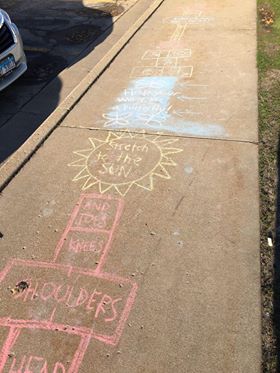|
 Jodie Merritt is mom to two girls, ages three and
five, who were previously involved in many activities. Merritt said,
“When everything started closing - school, play group, tumbling and
all of our favorite things, they were devastated.” Jodie Merritt is mom to two girls, ages three and
five, who were previously involved in many activities. Merritt said,
“When everything started closing - school, play group, tumbling and
all of our favorite things, they were devastated.”
To help them understand why places were closing, Merritt said, “I
happened to have a piece of paper in my hand, so my husband had us
all pass it around the room. He explained that we pass germs the
same way we passed around that piece of paper, plus we don’t know
for sure where it was before I had it.”
As Merritt said, “It was important to us for them to understand that
we were staying home because we didn’t want people to get sick. We
have to look out for our neighbors.”
Since Merritt and her husband often talk to the children about being
good neighbors, she said thankfully that made sense to them. Merritt
said, “If they want to go somewhere and we have to say no, they
understand it’s because of - from the words of my three-year-old -
‘the yickness’.”

Having been quarantined for two weeks, Merritt said the family has a
flexible routine and not a strict schedule.
After a slow start in the mornings with cartoons and tablet time,
Merritt said they usually do either Cosmic Kids Yoga or Go Noodle,
which can be found on any streaming device.
To help maintain some sense of normalcy, Merritt said, “We get
dressed so it feels like an actual start to a day.”
The family moves through different activities each day including
family devotional, exercise, snack time, craft time, and lunch time.


While Merritt works, the girls entertain themselves
with educational apps, quiet time in their own spaces and chilling
out for at least 30 minutes. Other activities include puzzles,
workbooks or schoolwork, stories, music, clean up and free play.
 [to top of second
column] |


Later in the afternoon, Merritt said it is a kind of
a free-for-all like any other day. On warm and sunny days, she said,
“we forget all of this and get as much fresh air and Vitamin D as
possible. None of our days look the same but having somewhat of a
routine helps keep us going if we get in a slump.”
Though that works for the family most days, Merritt said, “Some
days, it is jammies and every Frozen movie or clip we can find.”
For Merritt, “The worst thing we can do right now is compare
ourselves to others.” One worry Merritt has is “people thinking they
have to be at the top of their game every day.”

On the other hand, Merritt said, “The best thing we can do is look
for ideas that will help us thrive during this time. For us, if a
lazy day works, we roll with it, but if we’re stir-crazy, our
routine and time outside is always the answer. You know your family
best.”

One of the Merritt’s favorite outdoor activities is
doing a sidewalk chalk activity found on Pinterest. Merritt said,
“We set it up on the sidewalk outside our living room window so we
can see people who stop and do it as they’re walking by.”
Merritt said, “We have really enjoyed the creative ways people are
staying connected with their communities.”
[Angela Reiners]
Related links:
Talking to Kids about the Coronavirus
Making
a Sidewalk obstacle course with chalk
Aera Merritt tells how to use the obstacle course |